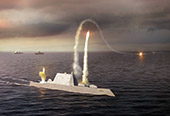Access Free VA Claims Assistance

Free Cancer Guide for Veterans

Find a Top Mesothelioma Doctor

Written by Aaron Munz | Edited By Walter Pacheco | Last Update: June 25, 2024
These ships had unrivaled agility and subsurface firepower. It allowed them to storm large armored ships, deploy their torpedoes and make a hasty retreat. The world’s navies quickly realized the devastating capabilities of the torpedo boat. They were indeed a formidable threat.
By the mid-1890s, many navies were building ships that could quickly dispose of the nimble torpedo boats. These ships became known as “torpedo boat destroyers,” and later evolved into the powerful destroyers that serve the U.S. Navy to this day.
Modern destroyers, like those of the Arleigh Burke ship class, are known as guided missile destroyers. They are equipped with the latest advances in military technology and structural design. In January 2022, the U.S. Navy was operating 69 active destroyers and plans to construct approximately 20 more.
These versatile ships contribute to numerous offensive and defensive missions.
Where was asbestos in your Navy ship?
Prior to the mid-1970s, the U.S. military used lots of materials containing asbestos to build and fix ships. This was because asbestos is good at keeping things cool and stopping fires from spreading. It was used in almost every part of a ship or shipyard. Examples include gaskets, valves, glue, cement and insulation on floors and pipes.
Many different kinds of asbestos products were used in many areas on navy ships. The navigation room, engine and boiler rooms, sleeping quarters and mess halls contained it.
Asbestos was mainly used for fire safety. Because there wasn’t good ventilation in these places, it was easy for asbestos fibers to stay trapped below deck. This increased the chance of exposure to harmful materials.
Navy veterans who served on ships built before 1983 encountered asbestos. Taking off insulation from engine and boiler rooms, or wrapping pipes with asbestos paste led to exposure. Navy pipefitters, welders and boiler workers were all at risk of this exposure.
In Navy shipyards, asbestos posed a serious threat to those on shore. Workers were often not given enough safety gear to protect them from inhaling it. Heavy exposures occurred frequently.
Evidence of abundant asbestos use aboard Navy vessels is confirmed with archived documents. In one 1946 memo, the Navy ordered the replacement of badly worn asbestos deck matting on USS Benner, a Gearing-class destroyer.

And a series of memos from the early 1940s detailed excessive asbestos use aboard 42 destroyers (DD 649 – 691). These ships contained woven asbestos deck matting, amosite asbestos insulation around cold water pipes and asbestos cloth on steam drums and F.O. heaters.
In a testimony to the Board of Veterans’ Appeals, one Navy veteran asserted that the collapse of his right lung was directly related to asbestos exposure aboard the USS Chevalier when he served during the Korean conflict. As a gunner’s mate, he was required to wear asbestos gloves while shooting guns and loading ammunition in combat.
He also reported asbestos exposure in his sleeping quarters, stating that hundreds of asbestos-insulated pipes passed through his living space. As the ship’s guns were fired, he described asbestos being shaken from the pipes in such great quantities that it appeared as if it were snowing.
Access Free VA Claims Assistance

Free Cancer Guide for Veterans

Find a Top Mesothelioma Doctor

In an 1898 report from the Naval War Board, Theodore Roosevelt, then assistant secretary of the Navy, identified Spanish torpedo boats as the only real threat to the U.S. Navy. With a conflict on the horizon, Congress approved the construction of 16 new destroyers to serve in the Spanish-American War.
By 1901 the Navy launched its first destroyer and the lead ship of her class, the USS Bainbridge. Placed in full commission on December 23, 1903, Bainbridge was armed with two 3-inch guns, five 6-pounders and two 18-inch torpedo tubes.
At the beginning of World War I, the Navy had improved the Bainbridge class ships. These new vessels were longer and could carry more weight, so they became escorts for bigger ships and submarine hunters. Even though America was not involved in the war at first, German submarines were still hurting people from America by attacking British merchantmen. On April 6th, 1917, America declared war on Germany to protect its citizens.
During World War I, American destroyers fought 250 battles against German submarines. They also safely transported 2 million people across the Atlantic Ocean without any lives being lost or ships sunk. By the end of the war, America had more destroyers than any other country in the world. After signing a treaty in 1922 called The Disarmament Treaty, over 200 ships were taken out of service and an extra 40 were recycled.
The Navy built no new destroyers from 1921 to 1934, but Adolf Hitler’s rise to power in the early 1930s prompted the construction of 45 new ships by the decade’s end. The newly commissioned ships were equipped with 5-inch, dual-purpose guns capable of surface and anti-aircraft fire, 20mm and 40mm anti-aircraft guns, multiple 21-inch torpedo mounts and depth charge projectors. Fast, powerful and efficient, these destroyers kept submarines at bay across both the Atlantic and Pacific oceans.
World War II destroyers performed a wide range of tasks in the Atlantic, from hunting and eliminating German submarines to rescuing fallen airmen. They also oversaw the landings in North Africa, Sicily and Europe, using their guns to take out shore batteries, clear the skies of enemy planes and protect Allied landing craft.
Once World War II came to an end, the Navy’s fleet of destroyers remained on standby until they were needed once again.

In the Korean War, the ships’ ability to enter shallow waters proved invaluable for delivering accurate gunfire support close to shore. They also vigilantly patrolled the seas during the Cuban Crisis of 1962, as well as the Vietnam conflict.
The modern, all-steel destroyers in service today are among the most powerful surface vessels on the water. The Navy plans to continue the destroyer’s legacy with the upcoming DDG 1000 Zumwalt-class destroyer, a multi-mission surface ship tailored for defending against current and projected threats.
Starting with USS Arleigh Burke (DDG 51), the Navy is modernizing its Arleigh Burke-class destroyers to ensure their relevance in future naval operations. A series of new DDG destroyers, commencing with USS Spruance (DDG 111), will soon be built and later joined by the upcoming Zumwalt-class destroyers.
This Page Contains 9 Cited Articles
The sources on all content featured in The Mesothelioma Center at Asbestos.com include medical and scientific studies, peer-reviewed studies and other research documents from reputable organizations.
Your web browser is no longer supported by Microsoft. Update your browser for more security, speed and compatibility.
If you are looking for mesothelioma support, please contact our Patient Advocates at (855) 404-4592
The Mesothelioma Center at Asbestos.com has provided patients and their loved ones the most updated and reliable information on mesothelioma and asbestos exposure since 2006.
Our team of Patient Advocates includes a medical doctor, a registered nurse, health services administrators, veterans, VA-accredited Claims Agents, an oncology patient navigator and hospice care expert. Their combined expertise means we help any mesothelioma patient or loved one through every step of their cancer journey.
More than 30 contributors, including mesothelioma doctors, survivors, health care professionals and other experts, have peer-reviewed our website and written unique research-driven articles to ensure you get the highest-quality medical and health information.
My family has only the highest compliment for the assistance and support that we received from The Mesothelioma Center. This is a staff of compassionate and knowledgeable individuals who respect what your family is experiencing and who go the extra mile to make an unfortunate diagnosis less stressful. Information and assistance were provided by The Mesothelioma Center at no cost to our family.LashawnMesothelioma patient’s daughter


Munz, A. (2024, June 25). Asbestos on Destroyers. Asbestos.com. Retrieved December 19, 2024, from https://www.asbestos.com/navy/destroyers/
Munz, Aaron. "Asbestos on Destroyers." Asbestos.com, 25 Jun 2024, https://www.asbestos.com/navy/destroyers/.
Munz, Aaron. "Asbestos on Destroyers." Asbestos.com. Last modified June 25, 2024. https://www.asbestos.com/navy/destroyers/.
Mesothelioma Center - Vital Services for Cancer Patients & Families doesn’t believe in selling customer information. However, as required by the new California Consumer Privacy Act (CCPA), you may record your preference to view or remove your personal information by completing the form below.
